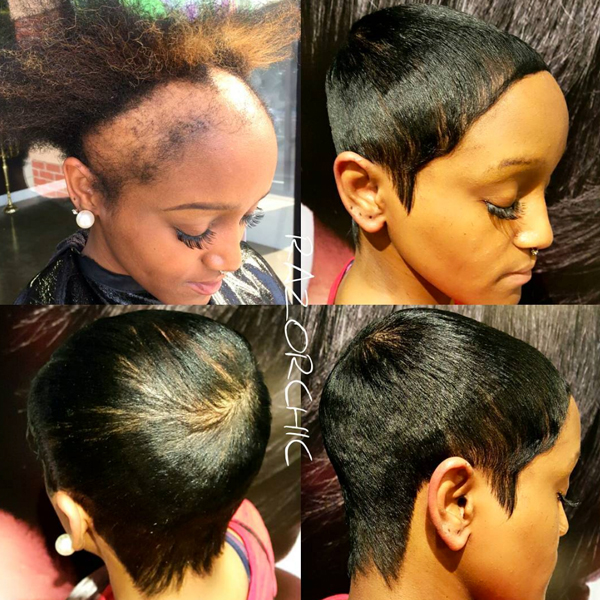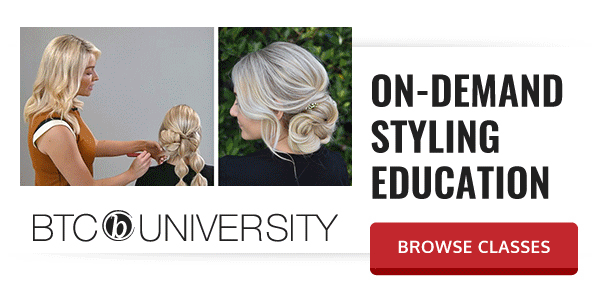This Stylist Is Freeing Her Clients From Their Weaves
Warning: Major Feels Ahead
Jasmine Collins (@theofficialrazorchic), owner of Razor Chic of Atlanta, is no ordinary stylist. She specializes in helping clients who suffer from extreme hair loss due to damaging extensions, braids and sew-ins transition to their natural hair, lowering their dependence on weaves.
Women come from all over the world to sit in Jasmine’s chair, and many of them have been wearing weaves for years—some as many as 20. “Some people who sit in my chair don’t have hair on the crown at all,” she says.
Jasmine also shares heartwarming videos of her clients seeing themselves with their own hair for the first time in years.
“I have to keep tissues at my station because so many of my clients haven’t seen themselves stripped of all the falseness in so long,” says Jasmine. “So when I spin them around and they see themselves—their real selves—they start to cry because they forgot what they looked like and what it felt like to be themselves.”
Many of her clients suffer from traction alopecia—gradual hair loss caused by constant tension on the hair, usually from tight braids, weaves and hairpieces. When she first started sharing before and after photos of these clients, hoping to make a difference by shining a light on the epidemic, her career took a major turn. And today, she has 560,000 followers and continues to make a difference in the industry by raising awareness for traction alopecia and helping her clients rebuild their self-esteem.
Below, Jasmine shares some of the secrets behind her stunning transformations.
Her process for traction alopecia clients normally looks like this:
1. Jasmine performs a thorough consultation. “When a client tells me they haven’t worn their natural hair for five or 10 years, this tells me they are used to convenience, so they need a convenient haircut that they can manage themselves so they won’t get frustrated and go back to the extensions,” she shares.
2. She then does a prep shampoo using NouriTress Shampoo to get rid of residue and oil and performs a blowout with a cool dryer. “At this point, I can actually see how to cut it,” she says.
3. Next comes the cut, which Jasmine says is the most important part. And with a precise haircut like the ones Jasmine gives, sectioning and paying attention to detail is very important.
4. Nine times out of 10, at this point the client will need a partial or full relaxer service, depending on the texture of the hair and the severity of the hair loss.
5. Next, Jasmine colors the hair. When dealing with hair loss, you want to choose dark colors to make it appear fuller—anything below a Level 3. “Most of the time when I’m dealing with hair loss I use black,” Jasmine says. “And I always use a semi- or demi-permanent color and 0 developer.”
6. After coloring, Jasmine applies a protein treatment or moisture mask to strengthen the hair.
7. Lastly, she styles the hair—paying attention to the client’s natural texture. A lot of the time her styles involve finger or pencil waves. “I like to go back to basics,” says Jasmine.
8. Jasmine tries not to use hair fillers, but on rare occasions, she uses NouriTress Make It Fuller Hair Building Fibers.
This is a process that varies from client to client, but Jasmine says it takes a minimum of four hours, and her average ticket is $500.
At-Home Care
- Depending on the amount of damage and the texture of the hair, Jasmine sends her clients home with a combination of NouriTress Shampoo, Conditioner, Hair Vitamins, Night Drops, VitaWrap Foaming Lotion and NouriSilk Serum.
- She also tells them to sleep on a satin pillow at night.
When Your Clients Can Wear Extensions
“I’m not anti-weave,” says Jasmine. “But I’m trying to get the message out there that you should be wearing your own hair more often than extensions, and if you’re not, it’s a major issue.”
So what are acceptable circumstances for weaves or extensions? Special occasions or for convenience, Jasmine says. “If you’re going on vacation, that’s totally understandable,” she says. “But when you’re not wearing your own hair for 10, 15, 20 years? That’s when it becomes a problem.”
Jasmine also says that to keep hair in a healthy state when using extensions, she prefers tape-ins or even bonding, and she always makes sure to use a minimal amount of glue.






